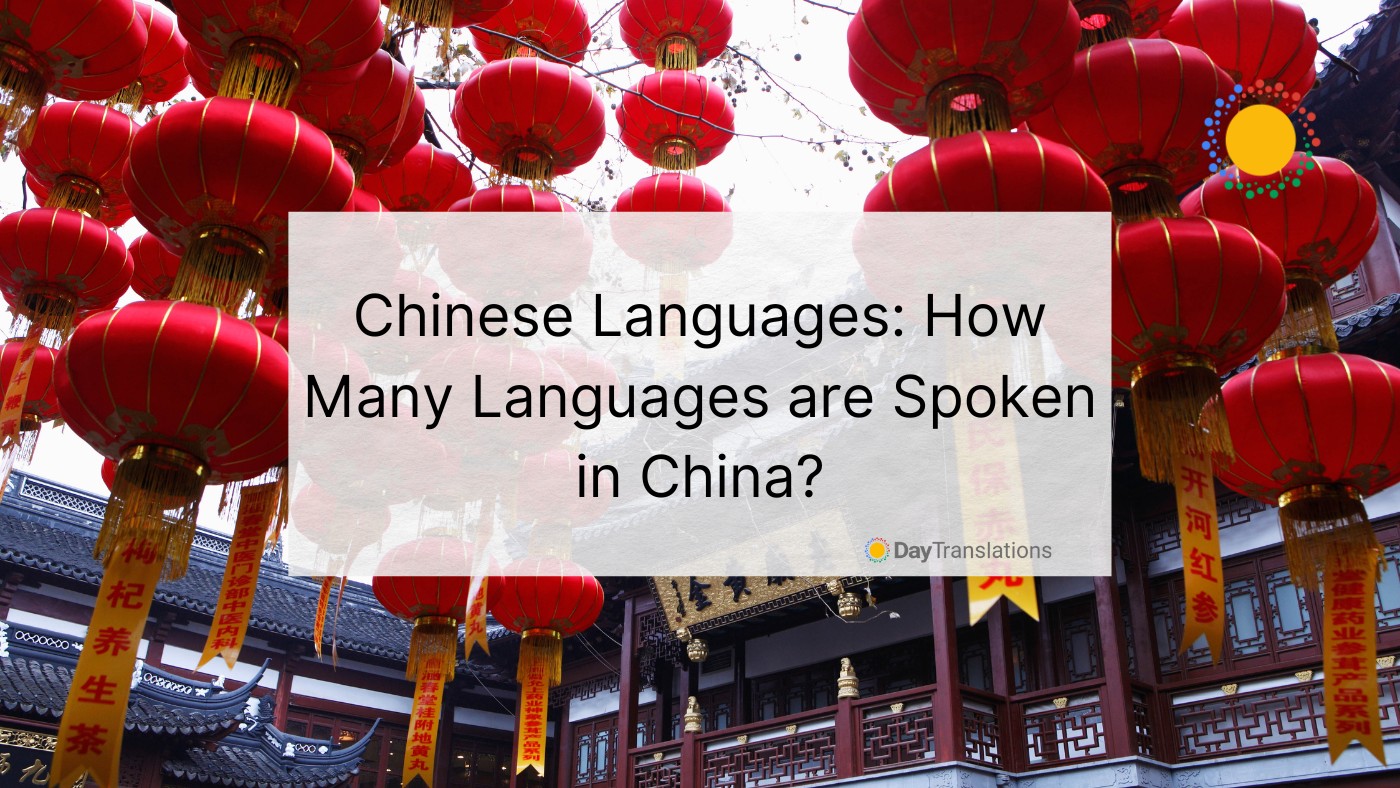China is the largest country in Asia, comprising a total area of 9,596,961 square kilometers or 3,705,407 square miles, and is distinguished for having many distinct features, including the variety of Chinese Languages. In early 2019, the Chinese population was estimated to be 1.4 billion, representing 18.41% of the world population, according to estimates done by the United Nations.
While most of the European languages were influenced and formed by Latin roots some 2000 years ago, Chinese was being shaped by its own lingua franca, Classical Chinese. In this post, we’ll be exploring the languages in China and the interesting varieties of Chinese. Ready to join us on a cultural submersion trip? Read on!
How Many Chinese Languages Are There?
China is distinguished for the number of languages spoken in the country. As of the latest data from Ethnologue, there are 302 individual living languages in China, 276 of which are indigenous. The United Nations celebrates April 20 as Chinese Language Day, which is part of the organization’s effort to promote the six official languages of China as well as celebrate linguistic and cultural diversity.
Incidentally, April 20 is also the date of the Guyu (Grain Rain/Rain of Millet) celebration of the Chinese, which honors Cangjie. It is an imaginary figure in Chinese folklore, which is said to have invented the Chinese characters. According to the folk tale, the ghosts and gods cried and the millet rained down from the sky when the characters were invented by Cangjie.
At this point it should be clarified that in China, they classify their languages as dialects, due to political reasons. Linguists may disagree, so in this article, the use of language and dialect is going to be interchangeable.
The Chinese language belongs to the Sino-Tibetan language family. It is one of the world’s largest language families. Chinese is spoken by 1.3 billion people around the world. Mandarin, which is probably the most recognized form of Chinese language, is just a dialect. Its use is widespread, but speakers of Mandarin Chinese will not be able to understand Cantonese, another Chinese language variant.
Many differences distinguish the Chinese dialects from one another. Despite the number of dialect, Pǔtōnghuà or Mandarin Chinese is the country’s official language since the 1930s.
Official Directive
While China’s national policy allows for cultural and regional autonomy and each region and dialect group is allowed to use their own language, they are also required to understand and speak the national language, which is Mandarin or Pǔtōnghuà, which means common language.
Before the 20th century, the different Chinese governments were not too concerned with the language issue. But in 1949, the government strongly supported the idea of having only one official language although concrete actions were only implemented in 1955. That year Mandarin was chosen as the official language of China and a directive was issued to teach the language in all schools and should be used in all aspects of life, from the army to journalism, commerce, industry, broadcasting as well as the interpreting and translation works.
The reform included changes in the written form of Chinese, with the government abolishing several characters and ordering the simplification of hundreds of characters.
Chinese Languages and Dialects
According to linguists there are seven (or 10) main groups of Chinese languages. Mandarin is the largest and others likewise have several sub-dialects. Interestingly, within each groups some dialects are mutually intelligible while there are others that are not. One of the reasons for this is the fact that many regions were geographically isolated. With no contact and interaction with their nearest neighbors, it is not impossible for them to only understand the dialects spoken within their own region. It should also be noted that these groups have millions of speakers are well.
It is difficult to fully grasp the complexity and diversity of the Chinese languages. Speakers of regional dialects may not understand one another, due to accents and pronunciations of characters. While the languages spoken in China are numerous, about seven groups are considered as the most important.
1. Mandarin
Mandarin is the top language among the groups. It’s arguably also the most widely-spoken language in the world. It’s also known as Northern Chinese, which is spoken by about two-thirds of the Chinese population. Other names for Mandarin include Standard Mandarin, Beijinghua, Zhongguohua and Beifang Fangyan. In China alone, Standard Mandarin is spoken as a first and second language by 1.082 billion people. All over the world, the total number of Mandarin speakers is 1.116 billion.
There are four subdivisions of Standard Mandarin Chinese.
1. Northern Mandarin
Spoken in the Northeast provinces like Manchuria, northern China and in the country’s capital, Beijing.
2. Northwestern Mandarin
Spoken in Baoji and the northwest provinces such as Ningxia, Xinjiang, Qinghai, Shaanxi and Gansu.
3. Southwestern Mandarin
Spoken in many parts of southwest China, Sichuan, Yunnan, Guizhou and Chongqing.
4. Southern Mandarin
Used in the provinces of Nanjing, Guangdong and Hainan.
Tones in the Chinese language indicate different meanings. Standard Mandarin has four tones such as level, rising, high rising and falling. These tones distinguish the syllables and words using the same vowels and consonants to determine the meaning of the word. Mandarin includes only a few words that end with a consonant. It has monosyllabic words and word elements but has no markers to indicate parts of speech or inflection.
2. Wu
On the coastal area in Shanghai, Wu is the Chinese dialect spoken. Wu is also known as Wúyuèyǔ, Goetian and Changzhou. In 2017, there were 81.4 million speakers of the Wu language in China. All over the world, the total number of Wu speakers is 81.5 million. It is spoken in several part of various provinces such as Zhejiang, Jiangxi, Jiangsu, Fujian, Anhui and the municipality of Shanghai. Wu is the second most common variant of the Chinese language.
Wu spread from the 5th century cultural center called Suzhou. It garnered more importance during the Ming Dynasty, because Shanghai was a vital metro area at that time. Wu has preserved the initial voiced stops and in using around seven or eight tones to differentiate the meanings of words and word elements that use the same vowels and consonants.
3. Yue
Yue is a dialect that is not mutually intelligible with the other Chinese dialects. It is also known as Cantonese, Yueyu, Yuet Yue and Yueh. It comes second after Mandarin in terms of use. There are about 62 million speakers of Yue in China but it is spoken by 73.5 million Chinese people all over the world. Yue or Cantonese is primarily spoken in the provinces of Guangdong, Hunan and Hainan and the Guangxi Zhuang Autonomous Region. Cantonese has 10 sub-dialects with Guangzhou variety being the standard.
Outside of China, Cantonese is spoken in Australia, Brunei, Canada, Hong Kong, Macao, Indonesia, Malaysia, the Philippines, Singapore, Suriname, Thailand and Vietnam.
Cantonese still has many features of Ancient Chinese, including the use of the final consonants. It has six tones and while it has fewer initial consonants, it has several syllables that are distinctly different. The majority of Chinese immigrants before the middle of the 20th century spoke Cantonese or Yue.
4. Xiang
In Southern China’s Hunan province, the dominant dialect is Xiang. Because most of the province is bordered by territories that speak Mandarin, the latter has a major impact on the Xiang language. Among the languages in the main groups, Xiang is the most similar to Mandarin. The language is divided into New Xiang and Old Xiang. The new variant is spoken in Hunan’s capital, Changsha. The old variety is dominant in Shuangfeng and many areas in Hunan. Old Xiang is similar to the Wu language in several aspect. It uses five tones and have more different initial consonants compared to the other major Chinese dialects.
5. Min
The population of Fujian province primarily speaks Min. It is also spoken in many parts of Taiwan, Hainan, Zhejiang and Guangdong. Min is a cluster of linguistically similar related Sinitic languages and is divided into five major variants:
1. Min Nan
Has about 50.5 million speakers who are located in Taiwan and Southeastern China. It also has several dialects, including Amoy or Xiamen. Speakers of Amoy use the dialect for trade
2. Min Dong
Has 10.3 million speakers.
3. Min Bei
Also known as Northern Min has 11 million speakers in several areas in the world, including Singapore, as of 2017.
4. Pu-Xian
Spoken by about 2.6 million in the counties of Xianyou and Putian of the Fujian province. It is also spoken in Singapore and Malaysia.
5. Min Zhong
Also known as Central Min (also known as Southern Min) is spoken in the municipalities of Yong’an and Sanming and the county of Sha in the province of Fujian. There were about 3.5 million speakers in 2017.
Min is a combination of the grammar and vocabulary of many periods in the Chinese language’s history.
While there are many speakers of Min, the history of its development made it difficult to find the right Chinese characters for the dialect, since most of the characters were created for the Mandarin language. Thus, written Min uses some Roman characters in place of the unavailable Mandarin characters.
The speakers of Min also use a special pronunciation called Tang Min that retains the final consonants used in Ancient Chinese for literary purposes.
6. Gan
More than 22 million people, most of them living in the parts of the provinces of Hunan, Fujian, Jiangxi and Hubei speak Gan, which is also known as Xi, Kan or Jiangxinese. Gan has several similarities to Hakka and its dialects. It still retains many archaic words that are no longer used in Mandarin. Gan is partially intelligible to Wu and Mandarin speakers but is more mutually intelligible to Hakka speakers.
7. Hakka
Hakka is distinct among the other groups in this list because it is spoken mainly in isolated regions, although the distribution is widespread. Due to the isolation of the speakers, it has about 13 dialects that are distinct from each other.
It has 43.5 million speakers in China and a total estimate of 48.5 million speakers including other areas. Hakka is greatly concentrated in the northeastern and eastern parts of Guangdong province, particularly in south Jiangxi, Hunan, Hainan, Guangxi and Fujian as well as the western and southwestern parts of Sichuan provinces. Speakers of Hakka can be found in Brunei, Cambodia, Hong Kong, Taiwan, French Guiana, French Polynesia, Indonesia, Malaysia, Panama, Suriname, Singapore and Thailand. Most of the immigrants in Indonesia, Malaysia and Thailand speak Hakka.
Hakka has six tones just like Cantonese and has similarities with Gan and the language as well as Hakka has borrowed extensively from Cantonese.
These are the seven major groups of different Chinese languages. Each one has a number of dialects, making the Chinese language very complex. Many of these are specifically spoken in individual locales, which require deep cultural and geographical knowledge from translators and interpreters.
In Mainland China and many areas overseas, Simplified Mandarin, which is the official script used in China, is applied for all written text. However, there are places such as Singapore that have developed its own style and vocabulary. With the variations, it is essential that you work only with a professional translator to ensure that your Chinese language translation is accurate.
What Is Simplified Chinese?
The short answer: It’s a Chinese writing system.
Did you know that there are three very distinct Chinese written languages? These are Traditional Chinese for Taiwan, Traditional Chinese for Hong Kong, and Simplified Chinese for mainland China. To the untrained eye, these three forms of written Chinese might look very similar, but there are a couple of significant differentiators between them. Here’s a quick look at the difference between traditional and simplified Chinese!
In essence, Simplified Chinese is, well, a simplification of the Traditional Chinese alphabet. This is done through the merging of character and stroke reduction.
You see, with over 50,000 characters in its lexical inventory, simplifying the Traditional Chinese alphabet was anything but simple. And it was until 1949, when The People’s Republic of China was established, that the official simplified writing system was developed.
The goal of this plan was to make reading and writing more accessible to the population. Chinese linguists and the government spent a few decades simplifying more than 2,000 Chinese characters. And today, it’s the standard writing system for more than a billion Chinese citizens.
Even though Traditional Chinese has diminished from everyday use in mainland China, it is still used in formal settings and to emphasize certain words and phrases. Many foreign media and subtitled video content from Hong Kong and Taiwan also contain Traditional Chinese. The simplification process, however, is of ongoing nature. The last edits made to the writing system were done in 2013 and we expect to see some more changes soon with the drive for globalization of the world economy. Just like the spoken languages in China continue to evolve, so will the writing system.
Understanding the Linguistic Diversity in China
A professional translation company like Day Translations, Inc. understands linguistic diversity. With a nation as large as China, it is understandable that it will have a number of languages. Our translators fully understand the differences between the various Chinese dialects. All our translators are native speakers and live in-country. You do not have to search for experts in Chinese translation services because it is very easy to get in touch with Day Translations, Inc. You can call us at 1-800-969-6853 or send us an email at Contact us at your convenience. We are available 24/7, every day of the year.












Sorry, the comment form is closed at this time.